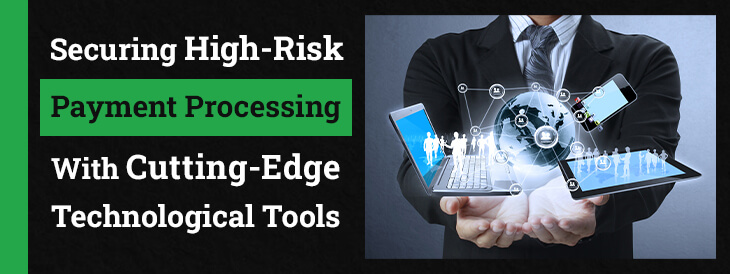Securing High-Risk Payment Processing with Cutting-Edge Technological Tools
Securing High-Risk Payment Processing with Cutting-Edge Technological Tools

In the world of high-risk payment processing, security, and risk management are top priorities for businesses and financial institutions. With the constant threat of fraudulent transactions and data breaches. It is crucial to have robust tools and systems in place to protect sensitive payment information. This is where technology plays a vital role.
From sophisticated fraud detection algorithms to advanced encryption methods. The role of technology in high-risk payment processing cannot be underestimated. In this blog post, we will explore how cutting-edge technological tools are being used to secure high-risk payment processing and the impact they have on the industry.
Understanding High-Risk Payment Processing
Navigating the realm of high-risk payment processing can feel like a daunting task. So, what does it entail? This term is typically assigned to transactions that carry a higher probability of fraud or chargebacks. Such transactions are common in industries labeled as high-risk, which include online gaming, e-commerce, telemarketing, and travel, among others.
The risks involved in these transactions are not just financial; they also carry the potential for increased regulatory oversight and potential reputational damage in the event of security breaches or fraud. Therefore, a robust understanding and effective management of high-risk payment processing are crucial for businesses operating in these sectors.
Some Related Blogs
- Streamlining Transactions: The Latest Payment Solutions For Forex Industry
- Automating Payment Integration In 3 Easy Steps
- How Recurring Payments Can Benefit High Risk Businesses
- Getting Approved For An Adult Merchant Account | Payment Guru
The Role of Technology in Fraud Detection and Prevention
In the dynamic landscape of high-risk payment processing, technology emerges as a game-changer, particularly in combating fraud. Cutting-edge tools harness the power of advanced algorithms and machine learning to analyze patterns, validate cardholder identities, and scrutinize transaction trends.
These automated systems, imbued with predictive capabilities, can anticipate potential fraudulent transactions with remarkable accuracy, aiding businesses in thwarting impending threats.
The judicious use of such tech-enabled defenses not only fortifies security around high-risk transactions but also helps avert financial setbacks. Ultimately, technology has transformed the way businesses approach fraud detection and prevention in high-risk payment processing.
Enhancing Security with End-to-End Encryption
As businesses engage in high-risk transactions, the need for impregnable data security is paramount. This is where end-to-end encryption steps in as a critical technology tool. This ingenious technique renders all sensitive information, such as credit card details, unreadable from the moment it is input into the system until it safely reaches its final stop.
The encrypted data remains indecipherable to potential hackers, even if they manage to intercept it during transit. With encryption in place, the risk of data breaches significantly reduces.
This technology not only shields businesses from potential security threats but also bolsters consumer confidence, as they can rest assured that their personal information is in safe hands. With end-to-end encryption, businesses can tread the high-risk payment processing path with increased confidence and security.
The Importance of Payment Gateway Integration
In the intricate matrix of high-risk payment processing, a secure payment gateway plays a key role. Serving as a conduit between a merchant’s digital platform and the banking system, it cloaks sensitive data in encryption, creating a robust security layer.
This secure passageway is integral to the safety of data as it journeys from the customer to the merchant and onward to the bank. The strategic integration of a reliable payment gateway significantly mitigates the risk of both fraud and chargebacks.
It’s like a virtual gatekeeper, continuously guarding the integrity of the transaction, promoting seamless and secure commerce.
Embracing a trustworthy payment gateway is not just about enhancing transaction security—it’s a proactive step toward fostering a secure shopping environment for customers.
Use of Blockchain Technology in High-Risk Payment Processing
As we navigate the intricate world of high-risk payment processing, the emergence of blockchain technology is a game-changer. This trailblazing tech offers a decentralized ledger that’s almost impervious to fraudulent activities, giving businesses a reliable tool for combating security breaches.
Blockchain’s transparent transaction tracking fosters greater trust, leading to increased confidence in high-risk transactions.
The technology does more than just enhance security—it also accelerates transaction speed in high-risk sectors, contributing to an improved user experience. By harnessing the power of blockchain technology, businesses can provide a secure, efficient, and trustworthy payment process, even in industries often flagged as high-risk.
The Future of High-Risk Payment Processing
Technological advancements herald a promising future for high-risk payment processing. By integrating robust tools like artificial intelligence, machine learning, and blockchain, businesses are transforming the risk landscape, making high-risk transactions safer than ever before.
They’re not just working to counteract fraud but also focusing on enhancing the user experience by ensuring smoother, secure transactions.
As businesses continue to leverage these technologies, high-risk payment processing is undergoing a significant evolution, making it more efficient and dependable. The future is bright, and it’s driven by technology, redefining the boundaries of what’s possible in high-risk payment processing.

Email us anytime!
Email customer service 24/7 at info@payment-guru.com

Call us anytime!
Reach customer care 24/7 at +1 (617) 616-8547
